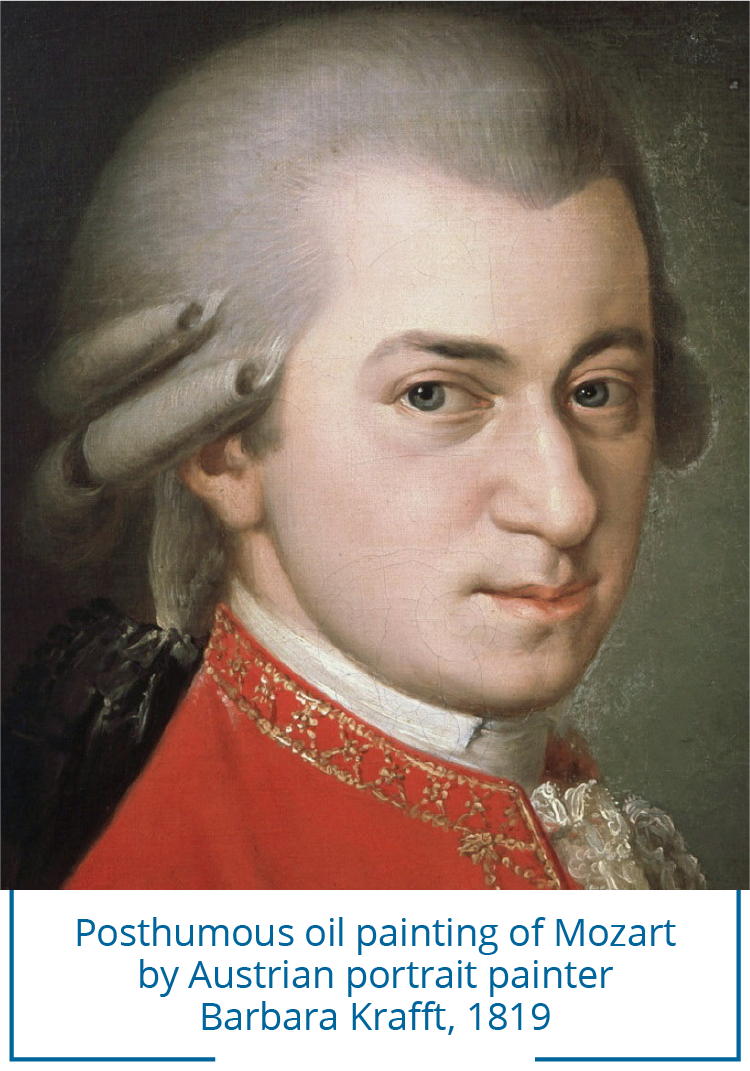ADAGIO IN E MAJOR, K. 261
Wolfgang Amadeus Mozart
(b. Salzburg, Austria, January 27, 1756; d. Vienna, December 5, 1791)
Composed 1776; 7 minutes
 Mozart played the five violin concertos he wrote during his teens while first concertmaster of the court orchestra in Salzburg. His skill on the violin was considerable. “I played as though I were the finest fiddler in all Europe,” he wrote to his father, after playing solo movements in one of his own serenades in Munich. His skill on the violin had taken the private gathering by surprise. “You yourself do not know how well you play the violin,” Leopold Mozart wrote in reply. “Many people do not even know that you play the violin, since you have been known from childhood as a keyboard player.” As one of the leading authorities on violin technique of his day, Leopold’s endorsement of his son’s skill on the instrument carries some weight. “Why, he could play anything,” Italian virtuoso Antonio Brunetti, Mozart’s successor in Salzburg, said to Leopold. Brunetti was evidently of the opinion that Mozart could compose anything, too, since on three occasions, he asked for substitute movements for Mozart concertos. As a result, we have three orphaned movements for violin and orchestra, two Rondos (K. 269 and K. 373) and the elegant E major Adagio, K. 261 that opens this evening’s concert. This was requested to replace the slow movement of the A major violin concerto, K. 219 which Brunetti found ’too studied’ or ’affected’ (studiert) for his liking, but which audiences ever since have found very much to their liking. The Adagio he received is a movement of great beauty and tranquility, maybe a little easier from a technical standpoint, and shorter.
Mozart played the five violin concertos he wrote during his teens while first concertmaster of the court orchestra in Salzburg. His skill on the violin was considerable. “I played as though I were the finest fiddler in all Europe,” he wrote to his father, after playing solo movements in one of his own serenades in Munich. His skill on the violin had taken the private gathering by surprise. “You yourself do not know how well you play the violin,” Leopold Mozart wrote in reply. “Many people do not even know that you play the violin, since you have been known from childhood as a keyboard player.” As one of the leading authorities on violin technique of his day, Leopold’s endorsement of his son’s skill on the instrument carries some weight. “Why, he could play anything,” Italian virtuoso Antonio Brunetti, Mozart’s successor in Salzburg, said to Leopold. Brunetti was evidently of the opinion that Mozart could compose anything, too, since on three occasions, he asked for substitute movements for Mozart concertos. As a result, we have three orphaned movements for violin and orchestra, two Rondos (K. 269 and K. 373) and the elegant E major Adagio, K. 261 that opens this evening’s concert. This was requested to replace the slow movement of the A major violin concerto, K. 219 which Brunetti found ’too studied’ or ’affected’ (studiert) for his liking, but which audiences ever since have found very much to their liking. The Adagio he received is a movement of great beauty and tranquility, maybe a little easier from a technical standpoint, and shorter.